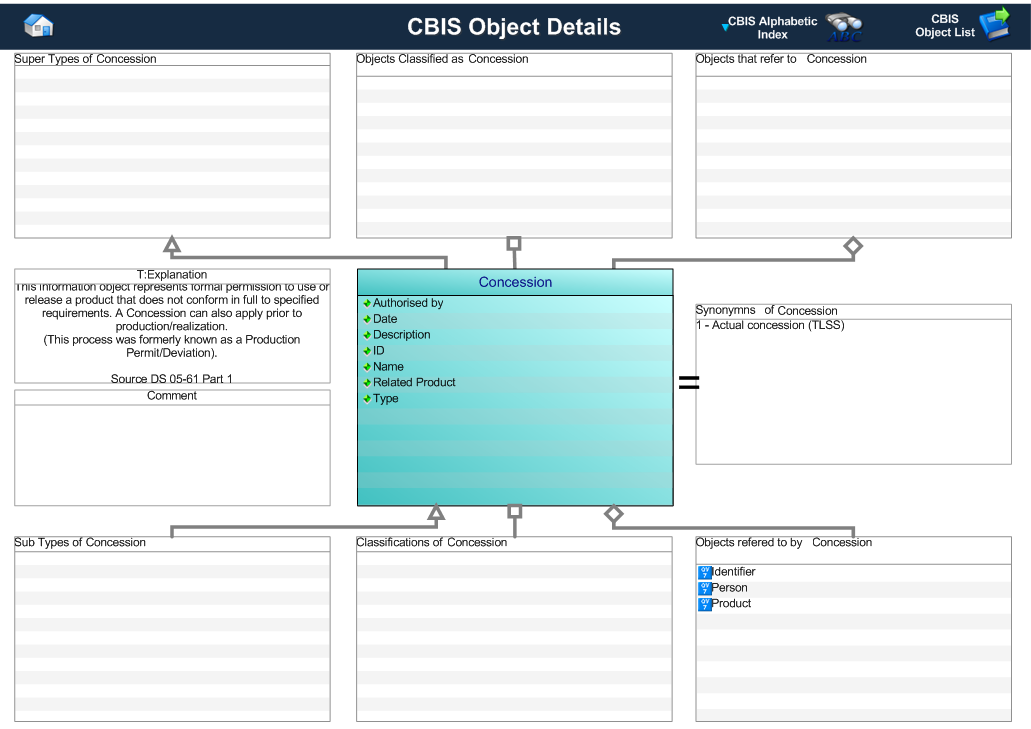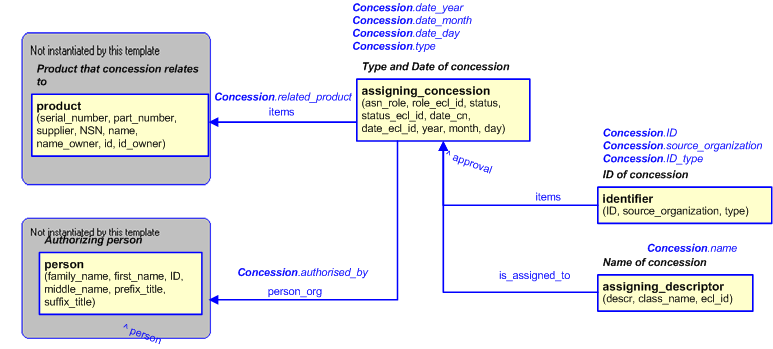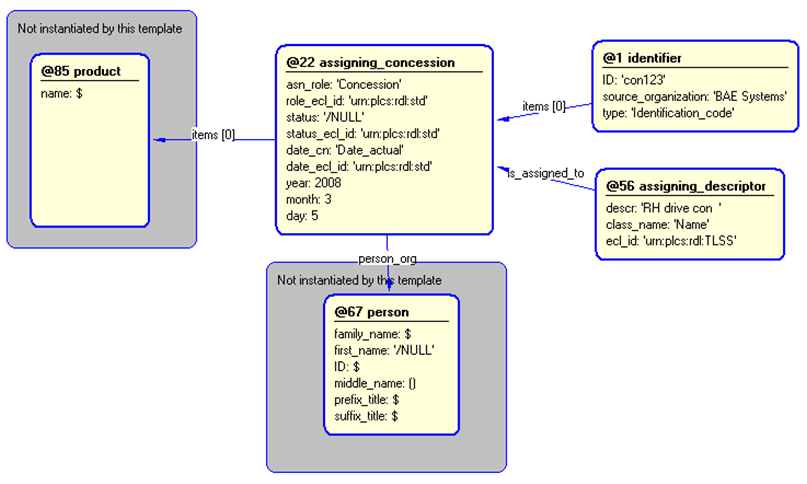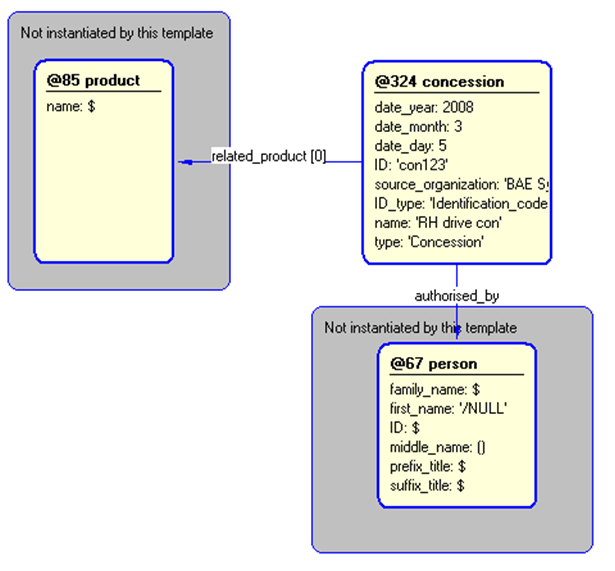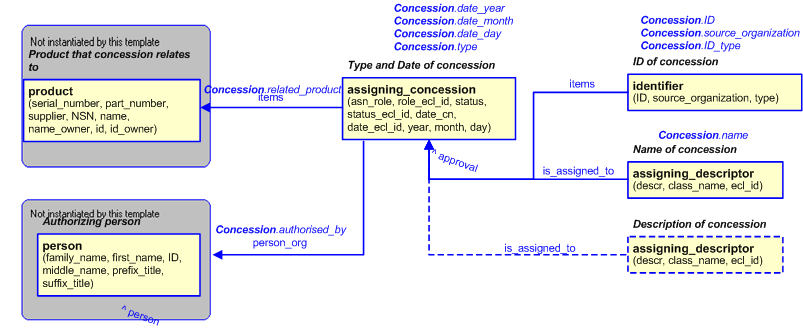Template:— concession (concn)
Context:— UK_Defence |
Date: 2009/04/17 10:33:08
Revision: 1.2
|
This section specifies the template concession.
NOTE
The template has been defined in the context of
UK_Defence.
Refer to the business context for details of related templates.
NOTE
An explanation of a template and the associated instantiation path is
provided in the
Template overview
section.
This template describes how to represent a UK_Defence concession, using
Approval.
This information object represents formal permission to use or release a product that does not
conform in full to specified requirements. A Concession can also apply prior to production/realization.
(This process was formerly known as a Production Permit/Deviation).
Source DS 05-61 Part 1
For further information about the representation of a concession, see below.
This information object represents formal permission to use or release a product that does not
conform in full to specified requirements.
Figure 1 — Graphical Representation for Business Object Concession
Record:
The definition of a concession object is:
This information object represents formal permission to use or release a product that does not
conform in full to specified requirements.
|
Attribute name
|
Attribute description
|
Attribute type
|
Optionality
|
| Authorised by |
This is the reference to the person that authorized the concession. |
Person |
Mandatory |
| Date |
This is the date on which the concession is defined to start. |
Intrinsic |
Mandatory |
| Description |
This is the description of the concession. |
Intrinsic |
Optional |
| ID |
This is the identifier of the concession. |
Identifier |
Mandatory |
| Name |
This is the name of the concession. |
Intrinsic |
Mandatory |
| Related Product |
This is the reference to the product(s) for which the concession has been raised |
Product |
Mandatory |
| Type |
This is the type of the concession.
EXAMPLE:
The categories include:
"concession",
"deferment",
"dispatch deviation
|
Intrinsic |
Mandatory |
Table 1 — Concesson attribute details
The EXPRESS-G diagram in
Figure
2
shows the templates and EXPRESS entities that are required
to represent the template
"concession".
The text highlighted in blue shows the template parameters.
Figure 2 — An EXPRESS-G representation of the Information model for concession
The graphic for the template to be used in other EXPRESS-G diagrams
is shown in Figure
3
below.
Figure 3 — The graphical representation of the concession template
The following input parameters are defined for this template:
This is the reference to the person that authorized the concession.
Year_component of the date on which the concession is defined to start
Month_component of the date on which the concession is defined to start
Day_component of the date on which the concession is defined to start
This is the identifier of the concession.
The organization that created the associated identifier. Additionally
a Person or Information System could be defined when either of these are the source; see Identifier template characterizations
This is the name of the type of the class used to classify the identifier and so
provide the role or reason for the identification.
The following classes and their sub-classes can be used:
This is the name of the concession.
This is the reference to the product(s) for which the concession has been raised
type (Default=Concession,Type='CLASS')
The type of the concession.
The following classes and their sub-classes can be used:
classifications:
"Concession"
(urn:plcs:rdl:std:Concession),
[Deferment]![[warning:]](../../../../../../images/dex/warning.gif) Error RDL4: The URI urn:plcs:rdl:uk_defence is not listed in dexlib/data/refdata/rdl_index.xml[Dispatch_deviation]
Error RDL4: The URI urn:plcs:rdl:uk_defence is not listed in dexlib/data/refdata/rdl_index.xml[Dispatch_deviation]![[warning:]](../../../../../../images/dex/warning.gif) Error RDL4: The URI urn:plcs:rdl:uk_defence is not listed in dexlib/data/refdata/rdl_index.xml
Error RDL4: The URI urn:plcs:rdl:uk_defence is not listed in dexlib/data/refdata/rdl_index.xml
The following reference parameters are defined for this template:
Allow the
Approval
entity instantiated in this path to be referenced when this template is used.
Note: The
Approval
entity can be referenced in a template path by:
%^target = $concession.approval%
where
target
is the parameter to which the
Approval
is bound.
The following parameter combinations specify a uniqueness constraint:
Unique constraint: Unique id
Each instance of the
entity
(
Approval)
within the data set shall be uniquely identified
by a combination of the following parameters on this
template (concession) namely:
ID,
name,
type.
The
instance is
referenced by the following template parameter:
approval.
The instantiation path shown below specifies the entities that are to be
instantiated by the template.
A description of templates and the syntax for the instantiation path is
provided in the
Templates Help/Information section.
/
assigning_concession(
asn_role=@type,
role_ecl_id='urn:plcs:rdl:std',
status='/NULL',
status_ecl_id='urn:plcs:rdl:std',
date_cn='Date_actual',
date_ecl_id='urn:plcs:rdl:std',
year=@date_year,
month=@date_month,
day=@date_day,
items=@related_product,
person_org=@authorised_by)/
%^approval = $assigning_concession.approval%
/
identifier(
ID=@ID,
source_organization=@source_organization,
type=@ID_type,
items=^approval)/
/
assigning_descriptor(
descr=@name,
class_name='Name',
ecl_id='urn:plcs:rdl:uk_defence',
is_assigned_to=^approval)/
The instance diagram in Figure
4
shows an example of the EXPRESS entities and templates that are instantiated by the template:
/concession(authorised_by='#67', date_year='2008', date_month='3', date_day='5', ID='con123', source_organization='BAE Systems', ID_type='Identification_code', name='RH drive con', related_product='#85', type='Concession')/
(an illustration of the consolidated concession template is shown in
Figure
5 below.)
Figure 4 — Entities instantiated by concession template
The instance diagram in
Figure
5
shows the graphic symbol for the template that is to be
used in other instance diagrams. The example template is:
/concession(authorised_by='#67', date_year='2008', date_month='3', date_day='5', ID='con123', source_organization='BAE Systems', ID_type='Identification_code', name='RH drive con', related_product='#85', type='Concession')/
Figure 5 — Instantiation of concession template
The following section details how the
concession
template can be optionally characterized by assigning
other constructs to it. These are characterizations commonly
applied to the template. The ISO 10303-239 EXPRESS model may enable
other assignments to the entities instantiated by the template.
The EXPRESS-G diagram in Figure
6
shows the possible characterizations of the template
"concession".
Figure 6 — Characterizations for concession
The following characterizations may apply:
Characterization Assigning description
NOTE this characterization is optional.
The description of the role can be
represented by assigning a descriptor
using the assigning_descriptor
template.
/assigning_descriptor(descr='RH drive hole drilled 0.2mm to right', class_name='Description', ecl_id='urn:plcs:rdl:std', is_assigned_to='#85')/
